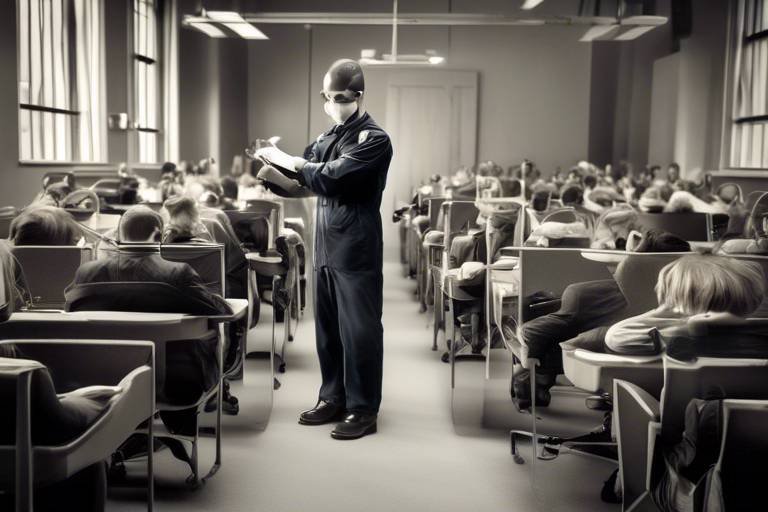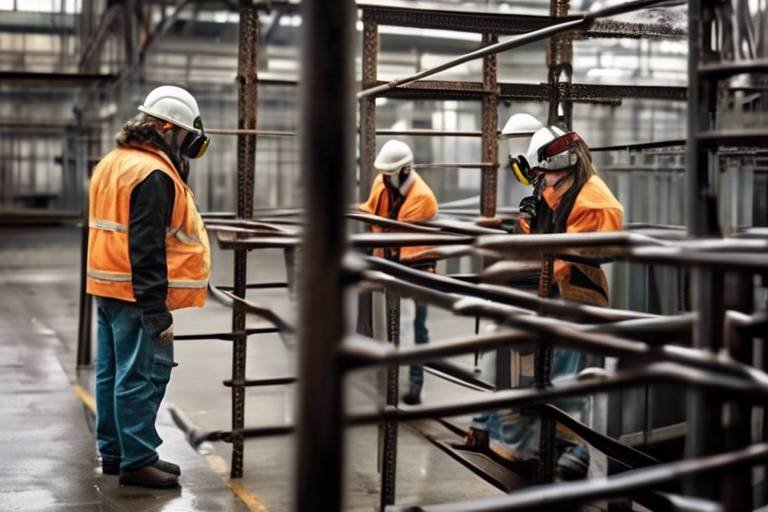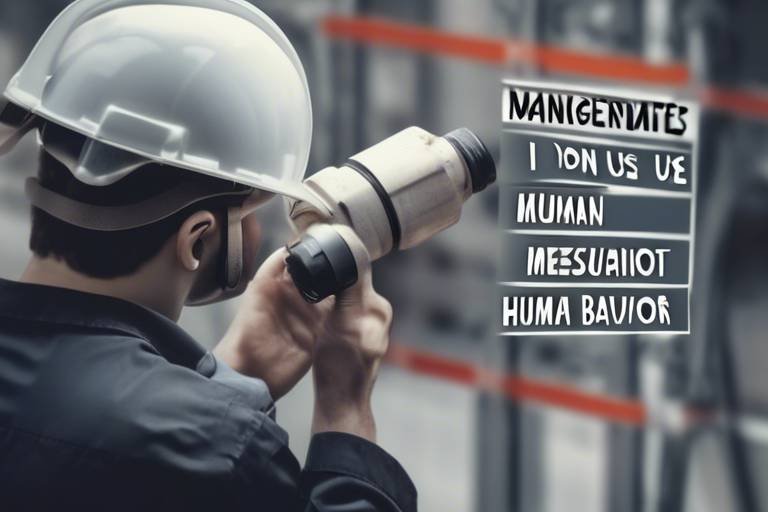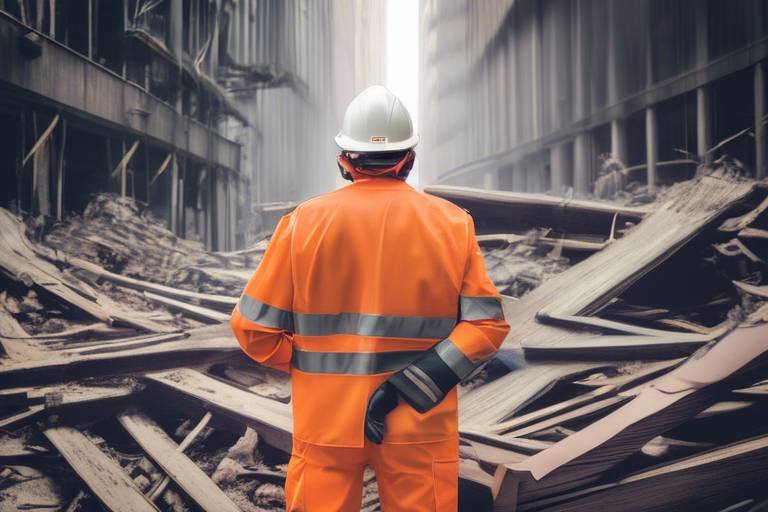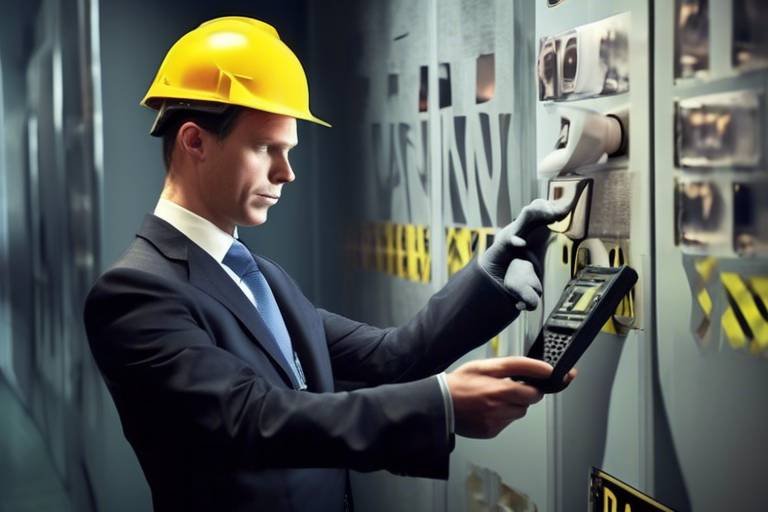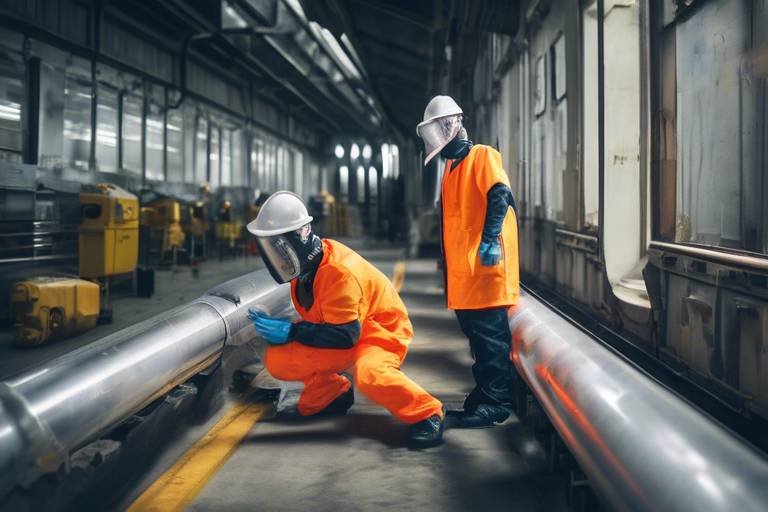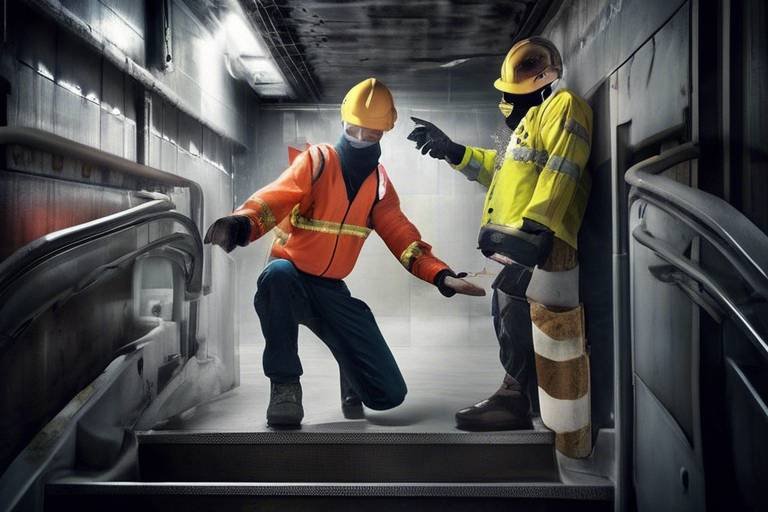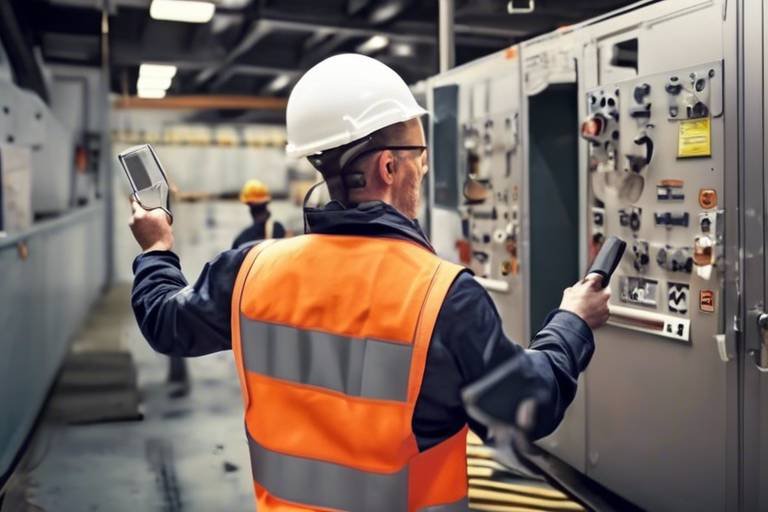Safety - Its Interdependence on Human Behaviour
In today's fast-paced world, the concept of safety is more crucial than ever. It's not just about having the right equipment or protocols in place; it's about understanding the intricate dance between human behavior and safety outcomes. Every day, individuals make choices that can either enhance or compromise safety, whether at work, home, or in public spaces. But have you ever stopped to think about how your actions impact the safety of those around you? This article delves into the vital relationship between safety protocols and human behavior, highlighting how individual actions can significantly influence safety outcomes across various environments.
When we talk about safety, it's easy to focus solely on the systems and structures designed to keep us safe. However, the reality is that human behavior plays an equally important role. For instance, consider a construction site where safety gear is mandated. If workers choose not to wear helmets or harnesses, the effectiveness of these safety protocols diminishes dramatically. This scenario illustrates a fundamental truth: no safety measure can be effective without the cooperation and commitment of individuals.
Moreover, the psychological factors that drive behavior are complex and multifaceted. People often engage in risky behaviors due to a variety of reasons, including peer pressure, lack of awareness, or simply underestimating potential hazards. Understanding these psychological elements is essential for developing effective safety measures. For example, if an organization can identify why employees might skip safety protocols—perhaps they feel invincible or believe that accidents won't happen to them—they can tailor their safety training to address these misconceptions directly.
As we explore this relationship further, it's essential to recognize that fostering a positive safety culture within organizations can significantly enhance safety outcomes. A strong safety culture encourages employees to prioritize safe practices and to speak up when they see unsafe behaviors in others. This creates an environment where safety is not just a set of rules, but a shared value that everyone upholds. So, what are the key elements that contribute to a robust safety culture? Let’s break it down:
| Element | Description |
|---|---|
| Leadership Commitment | Leaders must visibly prioritize safety and model safe behaviors. |
| Employee Involvement | Encouraging employees to participate in safety discussions and decisions enhances engagement. |
| Open Communication | Creating channels for reporting unsafe conditions without fear of reprisal is crucial. |
| Continuous Training | Regular safety training keeps safety top-of-mind and reinforces safe practices. |
In essence, the interdependence of safety and human behavior cannot be overstated. By recognizing the psychological drivers behind individual actions, organizations can implement more effective safety protocols that resonate with employees. This is not just about compliance; it's about cultivating a mindset where safety is woven into the fabric of daily operations.
- What is the most important factor in ensuring safety? The most important factor is fostering a culture of safety where individuals are aware and proactive about their actions.
- How can organizations improve their safety culture? Organizations can improve safety culture by promoting open communication, involving employees in safety decisions, and providing continuous training.
- Why do people engage in risky behaviors? People may engage in risky behaviors due to peer pressure, lack of awareness, or underestimating potential hazards.

The Role of Human Behavior in Safety
Understanding how human behavior influences safety is essential for developing effective safety measures. At its core, human behavior is influenced by a myriad of psychological factors, including perception, motivation, and social dynamics. Think about it: every time you step into a workplace, your actions—whether deliberate or instinctive—play a pivotal role in the overall safety landscape. Are you the type who follows safety protocols to the letter, or do you sometimes take shortcuts? Your choices can significantly impact not only your well-being but also the safety of those around you.
One of the most intriguing aspects of human behavior in safety is the dual nature of risk perception. For instance, some individuals may underestimate the dangers associated with certain tasks, believing that "it won't happen to me." This mindset can lead to risky behaviors, such as neglecting to wear personal protective equipment (PPE) or ignoring safety signage. Conversely, others may be overly cautious, potentially leading to inefficiencies and frustration in the workplace. It's a delicate balance, and understanding this spectrum of behavior is crucial for organizations aiming to foster a safe environment.
Moreover, the social environment cannot be overlooked. People often look to their peers for cues on how to behave. If a team member consistently disregards safety protocols, others may follow suit, believing that such behavior is acceptable. This is where the concept of norms comes into play. Establishing clear safety norms and encouraging a culture of accountability can help mitigate the risk of negative behaviors spreading within a team. For example, when employees see their colleagues actively participating in safety drills or reporting hazards, they are more likely to adopt similar behaviors.
Incorporating behavioral psychology into safety programs can also yield significant benefits. By understanding the motivations behind both safe and unsafe behaviors, organizations can tailor their training and interventions more effectively. For instance, using positive reinforcement to reward safe practices can create a more engaged workforce. Employees who feel recognized for their safe actions are likely to continue those behaviors, creating a ripple effect throughout the organization.
To illustrate the impact of human behavior on safety, consider the following table that highlights common behaviors and their potential consequences:
| Behavior | Potential Consequences |
|---|---|
| Wearing PPE consistently | Reduced risk of injury |
| Ignoring safety protocols | Increased likelihood of accidents |
| Reporting hazards | Improved workplace safety |
| Participating in safety training | Enhanced awareness and preparedness |
In conclusion, the role of human behavior in safety is multifaceted and deeply intertwined with organizational culture. By recognizing the psychological and social factors that drive behaviors, organizations can implement more effective safety measures. Remember, every action counts! Whether it's a small choice made by an individual or a collective decision made by a team, the ripple effects can significantly shape the safety culture within a workplace.

Safety Culture in Organizations
Creating a robust safety culture within organizations is not just about implementing rules and regulations; it’s about fostering an environment where safety is prioritized and ingrained in every aspect of the workplace. Imagine a workplace where every employee feels responsible for their own safety and the safety of their colleagues. This kind of culture can significantly reduce accidents and enhance overall productivity. But how do we cultivate such a culture?
At the heart of a strong safety culture lies the commitment from both management and employees. When leaders actively promote safety, it resonates throughout the organization. Employees are more likely to engage in safe practices when they see their leaders prioritizing safety in their decision-making processes. It’s a classic case of leading by example. If management is seen wearing safety gear, participating in safety drills, and openly discussing safety issues, employees are more likely to follow suit.
Moreover, a positive safety culture encourages open communication. Employees should feel comfortable voicing their concerns without fear of retribution. This leads to a more proactive approach to identifying and mitigating risks. Consider this: if a worker notices a potential hazard but fears reporting it, that hazard remains unaddressed, putting everyone at risk. Thus, organizations must establish clear channels for reporting safety concerns and ensure that feedback is not only welcomed but acted upon.
Another vital component is training and education. Regular training sessions can keep safety at the forefront of employees' minds. These sessions should be interactive and engaging, allowing employees to practice safe behaviors in a controlled environment. For instance, role-playing scenarios can help employees better understand how to respond to emergencies. Furthermore, ongoing education about new safety protocols or equipment can empower employees to take ownership of their safety responsibilities.
To better illustrate the elements that contribute to a strong safety culture, let's take a look at the following table:
| Element | Description |
|---|---|
| Leadership Commitment | Active support and involvement from management in safety initiatives. |
| Open Communication | Encouraging feedback and reporting of safety concerns without fear. |
| Training and Education | Regular training programs to reinforce safe practices. |
| Employee Involvement | Engaging employees in safety committees and decision-making. |
| Continuous Improvement | Regularly reviewing and updating safety protocols based on feedback. |
In summary, a strong safety culture is a collective effort that requires the commitment of everyone in the organization. By fostering an environment where safety is a shared responsibility, organizations can significantly reduce the likelihood of accidents and create a healthier workplace. It’s not just about compliance; it’s about creating a mindset that values safety above all else.
- What is safety culture? Safety culture refers to the shared values, beliefs, and behaviors regarding safety within an organization.
- Why is safety culture important? A strong safety culture leads to fewer accidents, improved morale, and increased productivity.
- How can organizations improve their safety culture? Organizations can improve their safety culture by promoting open communication, providing regular training, and involving employees in safety initiatives.
- What role does leadership play in safety culture? Leadership sets the tone for safety culture by modeling safe behaviors and prioritizing safety in decision-making.

Leadership's Influence on Safety
When it comes to safety in any organization, the old adage "lead by example" couldn't be more relevant. Leadership plays a pivotal role in shaping the safety culture within a workplace. Imagine a ship navigating through turbulent seas; if the captain is calm and collected, the crew is more likely to follow suit. Conversely, if the captain is panicking, chaos ensues. In the same vein, leaders who prioritize safety send a powerful message to their teams about the importance of safe practices.
One of the most significant ways leaders influence safety is through their commitment to safety protocols. When leaders actively participate in safety training and adhere to safety guidelines, it reinforces the idea that safety is a shared responsibility. This behavior not only boosts morale but also cultivates an environment where employees feel valued and protected. A strong commitment from leadership can transform safety from a mere checkbox activity into a core value of the organization.
Furthermore, effective leaders understand the importance of open communication. They foster an atmosphere where team members feel comfortable voicing concerns about safety without fear of retribution. This two-way communication is vital; it allows leaders to stay informed about potential hazards while empowering employees to take ownership of their safety. Regular safety meetings, suggestion boxes, and anonymous reporting systems can be valuable tools in this regard.
Another crucial aspect is the need for leaders to provide adequate resources and training. Just as a gardener nurtures plants with water and sunlight, leaders must equip their teams with the necessary tools and knowledge to maintain safety standards. This includes investing in safety gear, conducting regular training sessions, and ensuring that employees are well-informed about the latest safety protocols. A well-trained workforce is more likely to recognize hazards and respond appropriately, significantly reducing the likelihood of accidents.
Moreover, leaders should actively seek feedback from their teams regarding safety practices. This can be achieved through surveys or informal discussions where employees can express their thoughts on current safety measures. By taking feedback seriously and making adjustments when necessary, leaders demonstrate that they value their employees' insights, which can lead to a more engaged and safety-conscious workforce.
In conclusion, the influence of leadership on safety cannot be overstated. By leading by example, fostering open communication, providing necessary resources, and valuing employee feedback, leaders can create a robust safety culture that not only protects individuals but also enhances overall organizational performance. After all, a safe workplace is a productive workplace, and it all starts at the top.
- How can leaders effectively communicate safety protocols?
Leaders can hold regular safety meetings, utilize visual aids, and encourage open dialogue to ensure that safety protocols are clearly understood. - What role does employee feedback play in safety culture?
Employee feedback is crucial as it helps leaders identify areas for improvement and fosters a sense of ownership among staff regarding safety practices. - Why is training important for safety?
Training equips employees with the knowledge and skills necessary to recognize hazards and respond appropriately, significantly reducing the risk of accidents.

Communication Strategies for Safety
Effective communication is the backbone of any successful safety program. Imagine trying to navigate through a dense fog without a flashlight; that’s how employees feel when safety information isn’t communicated clearly. When it comes to ensuring safety in the workplace, it's not just about having the right protocols in place—it's about making sure everyone understands and adheres to them. This is where communication strategies come into play, acting as the guiding light in the fog.
One of the most impactful strategies is to foster an open dialogue among team members. When employees feel comfortable voicing their concerns or suggestions, it creates an environment where safety becomes a shared responsibility. Regular safety meetings can serve as a platform for discussing potential hazards and sharing best practices. These meetings should not be a mere formality; they should encourage active participation. Think of it as a team huddle before a big game—everyone should know their role and what to watch out for.
Another effective strategy is to utilize visual aids and signage throughout the workplace. A picture is worth a thousand words, and in safety, it can be a lifesaver. Clear, concise signage can remind employees of safety protocols and highlight potential hazards. For instance, using bright colors and easily recognizable symbols can draw attention to emergency exits or hazardous areas. This not only reinforces safety practices but also ensures that important information is readily accessible, even in high-pressure situations.
Moreover, leveraging technology can significantly enhance communication. Digital platforms can facilitate real-time updates and alerts regarding safety issues. For example, mobile apps that send notifications about safety drills, equipment maintenance schedules, or incident reports can keep everyone informed and engaged. Imagine receiving a push notification about a safety drill—this immediacy helps maintain a culture of safety awareness and preparedness.
Training sessions are another critical component of effective communication strategies. These sessions should not only cover the 'how-tos' of safety protocols but also emphasize the 'why' behind them. Understanding the reasoning behind safety measures can motivate employees to take them seriously. Utilizing role-playing scenarios can help employees visualize potential hazards and practice their responses. This hands-on approach can make the training more engaging and memorable.
Finally, feedback mechanisms are essential for continuous improvement in safety communication. Implementing anonymous surveys or suggestion boxes can encourage employees to share their thoughts on safety protocols without fear of repercussions. This feedback is invaluable as it can highlight areas needing improvement and reinforce what’s working well. Just like a coach reviews game footage to improve team performance, organizations must analyze feedback to enhance their safety strategies.
In summary, effective communication strategies for safety are multifaceted and require a blend of openness, visual aids, technology, training, and feedback. By fostering an environment where safety is a collective effort and ensuring that information flows freely, organizations can significantly reduce risks and enhance overall safety culture.
- What is the importance of communication in workplace safety? Effective communication ensures that all employees understand safety protocols, leading to a safer work environment.
- How can visual aids improve safety communication? Visual aids provide immediate reminders of safety practices and hazards, making it easier for employees to stay aware and vigilant.
- What role does technology play in safety communication? Technology facilitates real-time updates and alerts, keeping everyone informed about potential safety issues.
- Why is feedback important in safety communication? Feedback helps organizations identify areas for improvement and reinforces effective safety practices.

Training and Education
When it comes to safety, are not just important; they are absolutely essential. Imagine a ship sailing through stormy seas without a captain who knows how to navigate. That’s what it’s like when employees lack proper safety training. They may have the best intentions, but without the right knowledge and skills, they can inadvertently put themselves and others at risk. This is why organizations must prioritize ongoing training and education as part of their safety strategy.
Training programs should not be a one-time event. Instead, they need to be regularly updated and tailored to address the specific needs of the workforce. For instance, in a manufacturing environment, workers should be taught how to operate machinery safely, recognize hazards, and respond to emergencies. In the healthcare sector, staff must be trained on infection control practices and how to handle hazardous materials. The key is to ensure that all employees, regardless of their role, understand the safety protocols relevant to their specific tasks.
Moreover, effective training goes beyond just imparting knowledge. It should engage employees actively, encouraging them to participate in simulations, role-plays, and interactive discussions. This hands-on approach not only makes the learning process more enjoyable but also helps to reinforce important safety concepts. For example, consider a fire drill. It’s one thing to read about fire safety procedures, but it’s another to practice them in a controlled environment. This experiential learning can significantly improve an employee's ability to react appropriately in real-life situations.
Another critical aspect of training and education is the incorporation of feedback mechanisms. After training sessions, organizations should seek input from participants to assess the effectiveness of the program. Questions such as “What did you find most helpful?” or “What areas do you think need improvement?” can provide valuable insights. This feedback loop not only helps refine future training sessions but also empowers employees, making them feel valued and heard.
In addition to formal training, organizations should foster a culture of continuous learning. This can be achieved by providing access to resources such as online courses, safety manuals, and instructional videos. By making these resources readily available, employees can take the initiative to learn at their own pace, ensuring they remain informed about the latest safety practices and regulations.
To summarize, investing in training and education is paramount for enhancing safety in any organization. It equips employees with the necessary skills to perform their jobs safely and effectively while also creating a culture of safety awareness. As the saying goes, “an ounce of prevention is worth a pound of cure.” By prioritizing training, organizations can prevent accidents and injuries, ultimately leading to a safer workplace for everyone.
- Why is ongoing training important for safety?
Ongoing training ensures that employees remain up-to-date with the latest safety practices and protocols, which can change over time. - How can organizations assess the effectiveness of their training programs?
Organizations can assess effectiveness through feedback surveys, quizzes, and by monitoring safety performance metrics before and after training. - What types of training are most effective?
Interactive and hands-on training methods, such as simulations and role-playing, tend to be more effective than traditional lecture-based approaches.

Behavioral Safety Programs
When it comes to ensuring safety in the workplace, are often the unsung heroes. These programs focus on the actions and behaviors of employees, recognizing that human behavior is a critical factor in preventing accidents and injuries. Imagine a workplace where every individual is not just aware of safety protocols but actively participates in creating a safer environment. That’s the magic of behavioral safety programs—they transform safety from a mere checklist into a culture.
At the core of these programs is the principle that most accidents are caused by unsafe behaviors, rather than unsafe conditions. By identifying and modifying these behaviors, organizations can significantly reduce the likelihood of incidents. Think of it like training for a sport; you wouldn’t just practice the rules of the game—you’d also focus on the skills and strategies that help you play better. Similarly, behavioral safety programs emphasize training employees to recognize risky behaviors and make safer choices.
Implementing a behavioral safety program typically involves several key components:
- Observation and Feedback: Employees are encouraged to observe their peers and provide constructive feedback on safety practices. This creates a culture of accountability and continuous improvement.
- Training Sessions: Regular training helps reinforce safe behaviors and educate employees about the importance of safety in their daily tasks.
- Incentives: Recognizing and rewarding safe behaviors can motivate employees to prioritize safety, making it a core part of their work ethic.
A successful behavioral safety program doesn’t just aim to reduce accidents; it fosters a sense of ownership among employees. When individuals feel responsible for their own safety and that of their colleagues, they become more engaged and proactive. It’s akin to being part of a team where everyone looks out for one another, making safety a shared goal rather than a top-down mandate.
Moreover, these programs can be tailored to fit the specific needs of different industries. For instance, in manufacturing, the focus might be on machine operation safety, while in healthcare, it could center around patient handling and infection control. The flexibility of behavioral safety programs allows organizations to address their unique challenges effectively.
In conclusion, the impact of behavioral safety programs extends beyond simply reducing incidents; they cultivate a culture where safety is ingrained in every action. By empowering employees to take charge of their safety and encouraging open communication, organizations can create a proactive safety environment that not only protects workers but also enhances overall productivity. After all, a safe workplace is a productive workplace.
Q: What are behavioral safety programs?
A: Behavioral safety programs are initiatives designed to change employee behaviors to promote safety in the workplace. They focus on identifying unsafe behaviors and providing training and feedback to encourage safer practices.
Q: How do these programs reduce accidents?
A: By observing and modifying unsafe behaviors, providing regular training, and fostering a culture of accountability, behavioral safety programs help reduce the likelihood of accidents and injuries.
Q: Can these programs be customized for different industries?
A: Yes, behavioral safety programs can be tailored to meet the specific needs and challenges of various industries, ensuring that the safety measures are relevant and effective.
Q: What role do employees play in these programs?
A: Employees are encouraged to actively participate by observing their peers, providing feedback, and engaging in training sessions. This involvement helps create a sense of ownership and accountability for safety.

Environmental Factors Affecting Safety
When we talk about safety, we often think about rules, regulations, and protocols. However, there’s a whole world of environmental factors that can significantly impact safety outcomes. Imagine walking into a workplace where the layout is chaotic, machinery is poorly placed, and lighting is dim. It’s not just uncomfortable; it can be downright dangerous! The environment we work in plays a pivotal role in shaping our behaviors and, subsequently, our safety.
One of the most critical aspects of environmental safety is workplace design. A well-designed workspace can promote safe practices and minimize risks. For instance, consider the flow of movement in a factory. If workers have to navigate through tight spaces or around obstacles, the likelihood of accidents increases. On the flip side, a spacious layout with clearly marked pathways can enhance safety and efficiency.
Moreover, equipment layout is equally important. Machinery that is positioned too close to walkways or poorly guarded can lead to accidents. It’s essential to conduct regular assessments of equipment placement to ensure that it adheres to safety standards. A table summarizing some key environmental factors that affect safety can provide a clearer picture:
| Environmental Factor | Impact on Safety |
|---|---|
| Workplace Design | Influences movement and accessibility, affecting accident rates. |
| Lighting | Poor lighting can lead to missteps and injuries. |
| Noise Levels | High noise can distract workers, increasing the risk of accidents. |
| Temperature Control | Extreme temperatures can impair focus and physical ability. |
Another crucial element is lighting. Adequate lighting ensures that workers can see their surroundings clearly, reducing the chances of accidents. Imagine trying to operate machinery in a dimly lit area; it’s a recipe for disaster! On the contrary, well-lit environments not only boost productivity but also significantly enhance safety.
Additionally, noise levels within a work environment can’t be overlooked. Excessive noise can distract workers, making them less aware of their surroundings. This distraction can lead to mistakes and, ultimately, accidents. Implementing soundproofing measures or providing noise-canceling headphones can help mitigate these risks.
Finally, let’s not forget about temperature control. Working in extreme heat or cold can impair a worker’s physical abilities and focus. Ensuring that the workplace maintains a comfortable temperature is essential for keeping employees alert and safe. Organizations should invest in climate control systems to create a conducive working environment.
In conclusion, the interplay between environmental factors and safety is undeniable. By focusing on workplace design, lighting, noise levels, and temperature control, organizations can significantly enhance safety outcomes. Remember, a safe environment is not just about following rules; it’s about creating a space where safety is part of the culture. So next time you step into a workplace, take a moment to assess the environment—your safety might just depend on it!
- What are the most critical environmental factors affecting safety?
Workplace design, lighting, noise levels, and temperature control are among the most significant factors. - How can poor lighting impact safety?
Poor lighting can lead to missteps and injuries as workers may not see hazards clearly. - Why is workplace design important for safety?
A well-designed workspace promotes safe movement and minimizes risks of accidents. - What can organizations do to improve environmental safety?
Regular assessments of workplace conditions, investing in proper lighting and noise control, and ensuring temperature regulation can help enhance safety.

Risk Assessment and Management
In any organization, play a pivotal role in ensuring safety and minimizing hazards. It's like navigating through a maze; without a clear understanding of potential pitfalls, one can easily stumble into danger. The process involves systematically identifying, evaluating, and prioritizing risks, allowing organizations to implement strategies that mitigate these risks effectively. But how do we go about this? Let's break it down!
First and foremost, conducting thorough risk assessments is crucial. This involves a comprehensive analysis of the workplace to identify potential hazards that could impact safety. Think of it as a detective searching for clues; every nook and cranny must be examined. Common areas of focus include:
- Physical hazards (e.g., machinery, tools)
- Chemical hazards (e.g., exposure to toxic substances)
- Ergonomic hazards (e.g., repetitive strain injuries)
- Psychosocial hazards (e.g., workplace stress)
Once hazards are identified, the next step is to evaluate the risks associated with them. This evaluation considers the likelihood of an incident occurring and the potential severity of its consequences. A useful tool in this phase is the risk matrix, which helps categorize risks based on their severity and likelihood, allowing teams to prioritize their response effectively. For example:
| Likelihood | Severity | Risk Level |
|---|---|---|
| High | Severe | Critical |
| Medium | Moderate | High |
| Low | Minor | Low |
After assessing the risks, organizations must implement effective management strategies. This can include a variety of approaches, such as:
- Eliminating the hazard entirely
- Substituting with less hazardous options
- Implementing engineering controls (e.g., safety guards)
- Providing personal protective equipment (PPE)
- Establishing administrative controls (e.g., training, policies)
Moreover, it's essential to foster a culture of safety where employees feel empowered to report unsafe conditions and suggest improvements. Regular reviews and updates to the risk management plan ensure that it remains relevant and effective in addressing new challenges as they arise. This proactive approach not only enhances safety but also boosts morale, as employees recognize that their well-being is a priority.
In conclusion, effective risk assessment and management are not just about compliance; they are integral to building a safer workplace. By understanding the risks, evaluating them, and implementing appropriate management strategies, organizations can safeguard their employees and create a culture where safety thrives. Remember, safety isn't a one-time effort; it’s an ongoing commitment that requires vigilance and adaptability.
- What is the purpose of risk assessment?
Risk assessment aims to identify and evaluate potential hazards in the workplace to minimize risks and ensure employee safety. - How often should risk assessments be conducted?
Risk assessments should be conducted regularly, especially when there are changes in the workplace, such as new equipment or processes. - What are some common risk management strategies?
Common strategies include eliminating hazards, substituting safer materials, implementing engineering controls, and providing personal protective equipment. - Who is responsible for conducting risk assessments?
Typically, safety officers or designated personnel within an organization are responsible for conducting risk assessments, but all employees should be encouraged to participate.

Feedback Mechanisms for Continuous Improvement
In any organization, feedback mechanisms are not just a formality; they are the backbone of a thriving safety culture. Think of feedback as the pulse of an organization—it tells you how healthy your safety practices are and where you might need to make adjustments. Without it, you’re navigating in the dark, hoping for the best. So, how do we ensure that feedback is both effective and constructive?
First and foremost, it’s crucial to create an environment where employees feel safe to voice their concerns and suggestions. This can be achieved through regular surveys, one-on-one meetings, and even anonymous feedback tools. When employees know that their opinions matter, they are more likely to speak up when they observe unsafe practices or have ideas for improvement. Remember, feedback isn’t just about pointing out what’s wrong; it’s about fostering a culture of continuous improvement.
Moreover, feedback should be timely and specific. For instance, if a worker notices a potential hazard, addressing it immediately can prevent accidents. This is where technology can play a significant role. Many organizations are now leveraging mobile apps and digital platforms to allow instant feedback. Imagine a worker spotting a slip hazard and reporting it with just a few taps on their phone—this immediacy can be a game-changer in enhancing safety protocols.
Another critical aspect of effective feedback mechanisms is the follow-up. Once feedback has been gathered, it’s essential to communicate back to the team about what actions will be taken as a result. This not only shows that management values employee input but also reinforces a culture of accountability. For example, if a suggestion leads to a new safety protocol, sharing this success story can motivate others to contribute their ideas. It’s like planting seeds of improvement that can grow into a safer workplace.
To further illustrate the impact of feedback mechanisms, consider the following table that outlines the different types of feedback methods and their benefits:
| Feedback Method | Description | Benefits |
|---|---|---|
| Surveys | Anonymous questionnaires to gauge employee perceptions | Encourages honesty, collects a wide range of opinions |
| One-on-One Meetings | Personalized discussions between employees and managers | Builds trust, allows for in-depth feedback |
| Suggestion Boxes | Physical or digital boxes for anonymous suggestions | Encourages participation, allows for creative ideas |
| Digital Platforms | Apps that facilitate instant feedback | Immediate reporting, enhances responsiveness |
In addition to these methods, organizations should also implement a feedback loop. This means continuously assessing the feedback process itself. Are employees using the feedback tools? Are they finding them helpful? By regularly evaluating and refining these mechanisms, organizations can ensure they remain effective and relevant.
Lastly, it’s essential to celebrate the successes that come from feedback. When an employee’s suggestion leads to a significant safety improvement, recognize it publicly. This not only boosts morale but also encourages a cycle of positive reinforcement. After all, when employees see that their input leads to real change, they are more likely to engage in the feedback process again.
- What is the purpose of feedback mechanisms in safety? Feedback mechanisms help organizations identify areas for improvement, promote a culture of safety, and ensure that employees feel valued and heard.
- How can I encourage employees to provide feedback? Create a safe environment for sharing, use anonymous tools, and regularly remind employees of the importance of their input.
- What are some effective feedback methods? Surveys, one-on-one meetings, suggestion boxes, and digital platforms are all effective ways to gather feedback.
- How can feedback lead to continuous improvement? By implementing changes based on feedback and regularly evaluating the feedback process, organizations can foster a culture of ongoing enhancement in safety practices.
Frequently Asked Questions
- What is the relationship between human behavior and safety?
The relationship between human behavior and safety is deeply intertwined. Individual actions can significantly impact safety outcomes. For instance, a simple lapse in attention can lead to accidents, while proactive behaviors can enhance safety measures. Understanding this connection helps organizations develop strategies that promote safer practices.
- How can organizations foster a positive safety culture?
Organizations can foster a positive safety culture by encouraging open communication, promoting accountability, and providing ongoing training. When employees feel valued and heard, they are more likely to engage in safe practices. It's like building a team where everyone looks out for each other; the more connected they are, the safer the environment becomes.
- What role does leadership play in promoting safety?
Leadership is crucial in shaping a safety culture. Leaders set the tone for safety practices by modeling safe behaviors and holding themselves accountable. When leaders prioritize safety, it inspires employees to do the same. Think of it as a captain steering a ship; if the captain is vigilant about safety, the crew will likely follow suit.
- Why is communication important for safety?
Effective communication is vital for ensuring safety as it helps in spreading awareness about potential hazards and safety protocols. Clear communication can prevent misunderstandings that lead to accidents. It's akin to a well-orchestrated symphony where every musician knows their part; when everyone is on the same page, the result is a harmonious and safe environment.
- How often should training and education be conducted for safety?
Training and education should be ongoing to keep safety practices fresh in employees' minds. Regular training sessions help reinforce safe behaviors and adapt to new safety challenges. Think of it like practicing a sport; the more you train, the better you become at avoiding mistakes and enhancing performance.
- What are behavioral safety programs?
Behavioral safety programs focus on identifying and modifying unsafe behaviors to reduce accidents. These programs encourage employees to recognize and report unsafe practices, fostering a culture of safety awareness. It's like a buddy system where everyone looks out for one another, creating a safer workplace for all.
- How do environmental factors influence safety?
Environmental factors, such as workplace design and equipment layout, can significantly impact safety outcomes. A well-designed workspace can reduce hazards and promote safe behaviors. Imagine a cluttered desk versus a clean one; the latter allows for better focus and fewer accidents, showcasing the importance of environment in safety practices.
- What is the importance of risk assessment?
Conducting thorough risk assessments is crucial for identifying potential hazards before they lead to accidents. By evaluating risks, organizations can implement effective management strategies to mitigate them. It's like a detective solving a mystery; the more clues you gather, the better equipped you are to prevent future incidents.
- How can feedback mechanisms improve safety?
Feedback mechanisms are essential for enhancing safety practices as they allow organizations to learn from incidents and continuously improve protocols. Encouraging employees to provide input creates a culture of openness and accountability. Think of it as a feedback loop; the more you listen and adapt, the safer the environment becomes.




